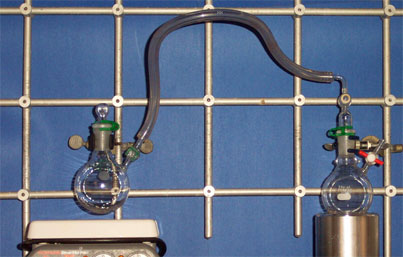 .
.
last updated
 .
.
Due to the fact that many of the compounds that are prepared in this lab course are air sensitive and sometimes also thermally not very stable, the solvent is often removed under reduced pressure in a static vacuum. The boiling point of the solvent will significantly decrease. The picture shows a simple flask-to-flask condensation setup consisting of two Schlenk flasks connected by a Tygon tubing (or adapter pieces) that permits such a solvent removal ('low temperature distillation'). There are several things that have to be considered setting up this condensation:
1. The flask on the left side, which will contain the solution to be concentrated, has to be stirred during the distillation. The formation of a solid product will lead to 'bumping' which causes major losses in product yield.
2. Evaporation of any compounds affords heat. Therefore the left flask will cool down and the evaporation rate will decrease significantly. To prevent the slowdown of the distillation the flask should be immersed in a warm water bath.
3. The flask on the right side has to be immersed in a Dewar flask which contains either a cooling bath (isopropanol/dry ice) or liquid nitrogen. Do not immerse the flask past the outlet of the stopcock.
4. Be aware that some solvents i.e. water will expand if they thaw. This means that the flask cannot be more than half-filled to allow for the expansion. The flask that is immersed into the Dewar should be at least one size bigger that the flask with the solution. This will prevent that the flask will be more than half full afterwards and provides enough surface to condense the solvent vapors efficiently.
5. To start the distillation, the setup is assembled before the stopcock of the gas adapter of the flask with the solution is closed. Next, the rest of the setup is evacuated using the the vacuum line. Then, the vacuum is disconnected from the entire setup. The stopcock of the gas adapter on the left side is opened slowly while stirring the solution. If the vacuum was strong enough, the solvent should condense in the flask on the right side. If not, the evacuation process is repeated until the vacuum is good enough to provide a good rate of condensation.
6. The solvents recovered from this distillation have to be disposed in the red solvent drums.